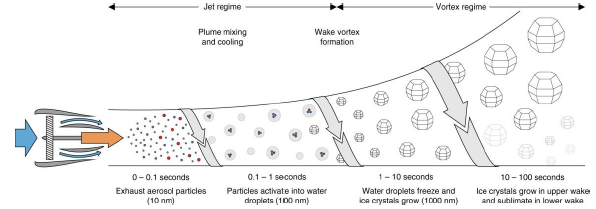Leeham News and Analysis
There's more to real news than a news release.
Bjorn’s Corner: Sustainable Air Transport. Part 56. SAF non-CO2 effects
February 3, 2023, ©. Leeham News: We’ve gone through the composition of Sustainable Aviation Fuel, SAF, its production, and its cost. We’ve also discussed its effect on CO2 emissions from Air Transport.
An important part of SAF’s advantages is its effect on non-CO2 emissions. It stems from its low content of Sulphur and Aromatic hydrocarbons.

Figure 1. Composition of Jet fuel. Source: CE Delft, Potential for reducing aviation non-CO2 emissions through cleaner jet fuel.
The non-CO2 emission problem
So far, the focus on the source of global warming has been our increase of CO2 emissions into the atmosphere from burning hydrocarbons, like Jet fuel for aviation. The composition of Jet A is shown in Figure 1.
The alkanes burn cleanly with the air’s O2 and form CO2 and H2O. The air also contains N2, which forms NOx, a less desirable output, as is SO2 from the Sulphur in Jet fuel.
The Sulphur combustion products condense on particle nuclei and fall out of the sky rather quickly. The troublemaker is the aromatics and especially naphthalene, which creates soot, as these do not burn (oxidize) very well in the combustor.
Soot is the instigator of contrails as it functions as the condensation nuclei for the exhaust’s water vapor. The end results in new Cirrus clouds that block the heat radiation out from Earth, thus increasing the average temperature, Figure 2.

Figure 2. The formation of contrails and Cirrus clouds from Jet fuel combustion. Source: Formation and radiative forcing of contrail cirrus, article in Nature by Kärcher.
The research around the contrails and Cirrus formation is recent, and common agreement on the gravity of the effects is not reached yet, but many say it has an even larger effect on air transport’s contribution to global warming than CO2.
The good news about the contrails is they and the generated Cirrus clouds are not persistent. It means if we can reduce the soot amount in the exhaust, the contrail formation is reduced. We can also adapt the flight altitude as the process in Figure 2 only happens under certain sub-cooled conditions, present at certain altitudes. Generated CO2 stays in the atmosphere for a long time.
How SAF reduces contrails
The different processes to produce SAF generate a cleaner fuel with almost no aromatics. It’s problematic when it comes to older fuel system seals as these rely on the aromatics to keep the seals elastic and tight by the swelling effect of aromatics. But the typical 20% of aromatics (whereof ~2-3% naphthalene) in Jet fuel can be halved as ASTM has certified fuels with 50% SAF as safe for older aircraft.
The non-CO2 characteristics of SAF increase its effect on reducing air transport’s contribution to reducing global warming beyond a more cyclic CO2 process. It also helps with contrails, which, as research gets more reliable facts, can be as important or more than SAF’s CO2 emission reduction.



The contrail claim is highly suspect. Contrails, in some conditions, form clouds. Clouds block/reflect light IN BOTH DIRECTIONS. There is absolutely no clear data suggesting that contrails add to heating.
Anyone who insists on “following the science” should immediately shun posts that suggest silly things like, “it has an even larger effect on air transport’s contribution to global warming than CO2.”
In the absence of actual DATA, destroying our aviation business on the basis of a few grant-seeking papers is insane.
What is the “actual DATA” you’re expecting? Many of those “grant-seeking papers” are peer reviewed and have solid science behind them.
I’m sorry you’re so emotional and triggered by something that seems critical of your source of livelihood, but please don’t mislead people. There has been a lot of academic study on this. Just one example: https://www.imperial.ac.uk/news/242017/clouds-created-aircraft-have-bigger-impact/
NASA report from 2013: https://www.earthdata.nasa.gov/learn/sensing-our-planet/on-the-trail-of-contrails
Prove them wrong then
Even the burning of sulfur in the fuel generates its part of power, it is noticeable in diesel cars were clean “City Diesel” or biodiesel increase the fuel consumption a tad.
Hi Bjorn, nice to see Leeham paying attention to this (re?-)emerging issue. Figure 2 is actually from https://www.nature.com/articles/s41467-018-04068-0 and adapted from an earlier paper. (I was the client for the CE Delft report cited.)
Thanks Jesper, I’ll change it.